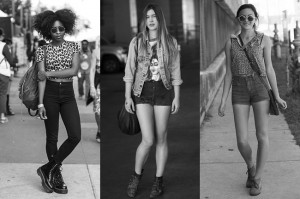Indiana Nash- Editor-in-Chief
For the past few years, there has been a new trend in the world of fashion bloggers that affects the way runway shows are reported. This trend is known as “Street Style” and merely refers to any style that is popularized by those gracing the streets of urban areas. Sounds pretty simple, right? Yet, this focus seems to be just as important as runway shows. The fashion industry is turning an eye towards the catwalks of the everyday, the models of the subway and the designers of the mundane.
The Sartorialist is one blogging website that really broke out with this ideal—that of creating an idea or story around what someone walking along the street is wearing. This website features thousands of beautiful pictures of everyday “muses,” accompanied by their prospective stories. Following the trend, there are blogs like Look Book and Who What Wear which celebrate the looks of everyday fashionistas. These sites also allow viewers to upload images of their own “street style” and have a space where it can be seen and appreciated by others.
Besides blogs, there are many power-house fashion magazines that have dedicated entire sections of their publication to this ideal. Vogue, Harper’s Bazaar and W magazine all have a fleet of photographers who have been assigned the task of street style watching. In fact, when runway shows are covered and Fashion Week is discussed, it is almost as important to document and capture what the show-goers are wearing as it is to capture the looks going down the runways. Not only are celebrities gaining more attention for their sense of “street style” but so are many who tend to work in the behind-the-scenes sectors of the fashion industry.
These looks and styles are popping up and inspiring the fashion focused everywhere. It is true that edgy fashions and new trends have always been inspired simply by observing those around us. Today, however, we’re able to “observe” vastly more than we ever have before and at an incredibly fast paced rate. That the ideal of celebrating “street style” should arrive at a time such as this should come as no surprise.
There are only a few downsides to this new-found source of celebration: that the styles observed may not be authentic and that more often than not, only a few newly found fashion muses are actually celebrated. In some ways, it can be considered a form of unauthentic creativity. If people begin to “dress-up” every day, can it still be considered true “street style”? The basis of the ideal is rooted in the interesting fashions of naturally chic or interestingly dressed street-goers. However, with the popularization of “street style” many are dressing not as they normally would, but as they believe a chic fashionista figure would. Instead of having a natural sense of “street style” that is truly effortless, many pour their efforts into seeming like a naturally stylish or trendy person.
People have always attended the latest fashion shows not only to see, but to be seen. Now, with blogs and other websites specifically encouraging this sort of ideal, it just encourages people to think before they dress. The catwalk is now not as exclusive a place as it once was. The street has turned into an entirely different space where one’s fashion choices can make almost as much of a splash in the world of fashion as the latest designs celebrated by those in the realm of high-end fashion.

Leave a Reply